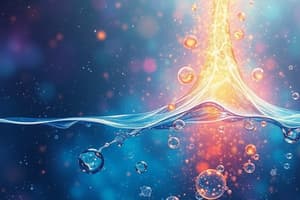Podcast
Questions and Answers
What is the calculated mass of chlorine (mg Cl) for Trial 2?
What is the calculated mass of chlorine (mg Cl) for Trial 2?
- 30.1989 mg
- 31.3179 mg
- 32.0000 mg
- 31.8291 mg (correct)
Which formula is used to calculate the % Cl in a sample?
Which formula is used to calculate the % Cl in a sample?
- %Cl = mg Cl / mg sample × 100 (correct)
- %Cl = mg sample / mg Cl × 100
- %Cl = mg sample × 100 / mg Cl
- %Cl = mg NaCl / mg sample × 100
Which value represents the average percentage of Cl from the trials?
Which value represents the average percentage of Cl from the trials?
- 62.28%
- 58.45%
- 61.77%
- 60.83% (correct)
Using dimensional analysis, what is the first step in calculating mg of Cl?
Using dimensional analysis, what is the first step in calculating mg of Cl?
If the formula mass of NaCl is 58.44 g/mol, what is the direct relationship between mg Cl and mg NaCl in the calculations?
If the formula mass of NaCl is 58.44 g/mol, what is the direct relationship between mg Cl and mg NaCl in the calculations?
What is the purpose of standardizing a silver nitrate solution in precipitation titration?
What is the purpose of standardizing a silver nitrate solution in precipitation titration?
Which of the following compounds is known to form a precipitate when reacting with potassium iodide?
Which of the following compounds is known to form a precipitate when reacting with potassium iodide?
In a precipitation reaction, what determines which compound will precipitate?
In a precipitation reaction, what determines which compound will precipitate?
What is the end product of the reaction between sodium carbonate and calcium chloride?
What is the end product of the reaction between sodium carbonate and calcium chloride?
Which of the following ions does NOT follow the common solubility guidelines for ionic compounds?
Which of the following ions does NOT follow the common solubility guidelines for ionic compounds?
Which of the following statements is true regarding precipitation reactions?
Which of the following statements is true regarding precipitation reactions?
In the Mohr method, which ion is primarily measured to determine chloride concentration?
In the Mohr method, which ion is primarily measured to determine chloride concentration?
What type of reaction occurs when two ionic compounds are mixed and produce a solid precipitate?
What type of reaction occurs when two ionic compounds are mixed and produce a solid precipitate?
What factor primarily influences the pH at the post-equivalence point in a titration?
What factor primarily influences the pH at the post-equivalence point in a titration?
What is the primary purpose of standardizing a standard solution?
What is the primary purpose of standardizing a standard solution?
In the example calculation for trial 1, what is the correct volume of NaOH used based on the given weight of KHP?
In the example calculation for trial 1, what is the correct volume of NaOH used based on the given weight of KHP?
What unit conversion is necessary to calculate the molarity of NaOH during the standardization process?
What unit conversion is necessary to calculate the molarity of NaOH during the standardization process?
What is a vital outcome of proper dimensional analysis during calculations?
What is a vital outcome of proper dimensional analysis during calculations?
What is the value of the ion-product constant for water, $K_w$, at 25°C?
What is the value of the ion-product constant for water, $K_w$, at 25°C?
Which of the following correctly represents the average molarity of the NaOH standard solution based on the trials?
Which of the following correctly represents the average molarity of the NaOH standard solution based on the trials?
How do you calculate pOH from the hydroxide ion concentration?
How do you calculate pOH from the hydroxide ion concentration?
In the calculation for determining the volume of NaOH needed, what is the role of KHP?
In the calculation for determining the volume of NaOH needed, what is the role of KHP?
Given that $[H_3O+] = 3.4 imes 10^{-4} M$, what is the concentration of hydroxide ions, $[OH-]$, in the solution?
Given that $[H_3O+] = 3.4 imes 10^{-4} M$, what is the concentration of hydroxide ions, $[OH-]$, in the solution?
What must be calculated alongside the volume of NaOH used to determine the concentration of acetic acid in vinegar?
What must be calculated alongside the volume of NaOH used to determine the concentration of acetic acid in vinegar?
What is the pH of a solution that is 0.100 M in HCl?
What is the pH of a solution that is 0.100 M in HCl?
At the equivalence point of a titration of HCl with NaOH, what is the primary factor determining the pH?
At the equivalence point of a titration of HCl with NaOH, what is the primary factor determining the pH?
What relationship holds true for pH and pOH at 25°C?
What relationship holds true for pH and pOH at 25°C?
What is the effect of adding 10.0 mL of 0.200 M NaOH to 50.0 mL of 0.100 M HCl on the resulting concentration of HCl?
What is the effect of adding 10.0 mL of 0.200 M NaOH to 50.0 mL of 0.100 M HCl on the resulting concentration of HCl?
What is the pH of a solution after adding 30 mL of NaOH to 50 mL of 0.100 M HCl?
What is the pH of a solution after adding 30 mL of NaOH to 50 mL of 0.100 M HCl?
At what point during the titration of a strong acid with a strong base is the pH equal to 7?
At what point during the titration of a strong acid with a strong base is the pH equal to 7?
How is the concentration of hydroxide ions related to the amount of excess NaOH added past the equivalence point?
How is the concentration of hydroxide ions related to the amount of excess NaOH added past the equivalence point?
What volume of NaOH is needed to completely neutralize 50.0 mL of 0.100 M acetic acid?
What volume of NaOH is needed to completely neutralize 50.0 mL of 0.100 M acetic acid?
What is the hydroxonium ion concentration after adding 30 mL of NaOH to the original acid solution?
What is the hydroxonium ion concentration after adding 30 mL of NaOH to the original acid solution?
What happens to the pH as you approach the equivalence point in a titration of a weak acid with a strong base?
What happens to the pH as you approach the equivalence point in a titration of a weak acid with a strong base?
What is the $K_a$ expression for acetic acid during its dissociation in water?
What is the $K_a$ expression for acetic acid during its dissociation in water?
In the titration of a strong base with a weak acid like acetic acid, what can be expected once the equivalence point is surpassed?
In the titration of a strong base with a weak acid like acetic acid, what can be expected once the equivalence point is surpassed?
Flashcards are hidden until you start studying
Study Notes
Water Auto-Ionization
- Water molecules undergo a reversible reaction to form hydronium (H3O+H_3O^+H3O+) and hydroxide (OH−OH^-OH−) ions.
- The equilibrium expression for this process is Kw=[H3O+][OH−]K_w = [H_3O^+][OH-]Kw=[H3O+][OH−], where KwK_wKw is the ion-product constant for water.
- At 25°C, Kw=1.0×10−14K_w = 1.0 × 10^{-14}Kw=1.0×10−14.
- In pure water, [H3O+]=[OH−]=1.0×10−7[H_3O^+]=[OH^-]=1.0 × 10^{-7}[H3O+]=[OH−]=1.0×10−7 M.
pH, pOH, and pKw
- pH is the negative logarithm of the hydronium ion concentration: pH=−log[H3O+]pH = -log[H_3O^+]pH=−log[H3O+].
- Similarly, pOH is the negative logarithm of the hydroxide ion concentration: pOH=−log[OH−]pOH = -log[OH-]pOH=−log[OH−].
- The relationship between pH, pOH, and pKw is: pH+pOH=pKw=14.00pH + pOH = pK_w = 14.00pH+pOH=pKw=14.00.
Sample Exercise: Calculating [OH-] and pH
- A solution with [H3O+]=3.4×10−4M[H_3O^+]=3.4 × 10^{-4} M[H3O+]=3.4×10−4M is acidic because its pH is less than 7.
- The [OH−][OH^-][OH−] can be calculated using the KwK_wKw expression: [OH−]=1.0×10−14[H3O+][OH-]=\frac{1.0 × 10^{-14}}{[H_3O^+]}[OH−]=[H3O+]1.0×10−14.
Titration of Strong Acids and Strong Bases
- The reaction between a strong acid and a strong base is a neutralization reaction: H3O+(aq)+OH−(aq)→2H2O(l)H_3O^+(aq) + OH^-(aq) \rightarrow 2H_2O(l)H3O+(aq)+OH−(aq)→2H2O(l).
- The equivalence point is reached when the moles of acid and base are equal.
- The volume of titrant needed to reach the equivalence point can be calculated using the equation: Ma×Va=Mb×VbM_a \times V_a = M_b \times V_bMa×Va=Mb×Vb.
- Before the equivalence point, the pH is determined by the excess acid concentration.
- At the equivalence point, the pH is 7.00.
- After the equivalence point, the pH is determined by the excess base concentration.
Titration Curve of a Strong Acid with a Strong Base
- The titration curve of a strong acid with a strong base shows a steep rise near the equivalence point.
- The pH at the equivalence point is 7.00.
Titration of a Weak Acid with a Strong Base
- The reaction between a weak acid and a strong base produces the conjugate base of the weak acid.
- The pH is calculated using the KaK_aKa expression for the weak acid.
- The equivalence point is reached when the moles of acid and base are equal.
- The pH at the equivalence point is greater than 7.00.
Experiment 3: Determination of Acetic Acid Content in Vinegar
- The concentration of acetic acid in vinegar can be determined by titrating it with a standardized NaOH solution.
- The standardization of NaOH solution involves titrating it with a primary standard (KHP).
- The data from the titration is used to calculate the concentration of acetic acid in the vinegar sample using stoichiometry and dimensional analysis.
- The volume of NaOH needed to reach the equivalence point is calculated using the equation: molCH3COOH=molNaOHmol CH_3COOH = mol NaOHmolCH3COOH=molNaOH.
- The titration curve of a weak acid with a strong base shows a gradual rise near the equivalence point.
Precipitation Titration
- A precipitation titration is based on the reaction between two ionic compounds to form an insoluble precipitate.
- The equivalence point is reached when the stoichiometric amount of titrant has been added to react with the analyte.
- The Mohr method is used to determine the chloride concentration using a standard solution of silver nitrate.
- The concentration of chloride in the sample can be calculated in terms of mg/L and % NaCl using dimensional analysis.
Solubility
- The solubility of a substance is the amount of the substance that can be dissolved in a given quantity of solvent at a given temperature.
- The solubility guidelines for common ionic compounds can be used to predict which compounds are soluble or insoluble in water.
- The solubility of a compound is affected by several factors, including temperature and the presence of other ions in the solution.
Studying That Suits You
Use AI to generate personalized quizzes and flashcards to suit your learning preferences.




